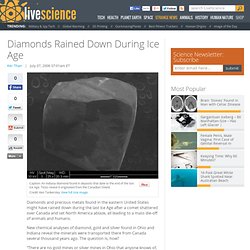

Diamonds Rained Down During Ice Age. Diamonds and precious metals found in the eastern United States might have rained down during the last Ice Age after a comet shattered over Canada and set North America ablaze, all leading to a mass die-off of animals and humans.

New chemical analyses of diamond, gold and silver found in Ohio and Indiana reveal the minerals were transported there from Canada several thousand years ago. The question is, how? "There are no gold mines or silver mines in Ohio that anyone knows of, but there are plenty of them in Canada," said retired geophysicist Allen West, who was involved in the study. The discovery is consistent with a theory proposed by West and colleagues that a 3-mile-wide comet splintered over glaciers and ice sheets in eastern Canada about 12,900 years ago and wiped out man and beast.
"These would have been like ten thousand Tunguskas going off at once," said West, referring to a mid-air explosion over Siberia a century ago possibly caused by a fragmenting meteor. Precious rain. New evidence that asteroid smacked Earth - Technology & science - Space - Space.com. New evidence supports the idea that a huge space rock collided with our planet about 13,000 years ago and broke up in Earth's atmosphere, a new study suggests.
This impact would have been powerful enough to melt the ground, and could have killed off many large mammals and humans. It may even have set off a period of unusual cold called the Younger Dryas that began at that time, researchers say. The idea that Earth experienced an asteroid or comet impact at the start of the Younger Dryas has been controversial, in part because there is no smoking-gun impact crater left behind as with other known events in our planet's past. But researchers say it's common for space rocks to disintegrate in the heat of a planet's atmosphere before they can reach the ground. The scientists first reported their suspicions about the event in 2007. Canadian comet impact fingered for triggering prehistoric climate shift. High performance access to file storage Scientists have discovered new evidence that an extraplanetary body came down over Canada around 12,900 years ago, possibly triggering the death of the giant animals then roaming the North American continent, and starting a cooling spell that helped drive mankind towards agriculture and civilization.

During the Younger Dryas climatic period, which kicked off around 13,000 years ago, world temperatures fell sharply, with parts of the northern hemisphere dropping around five degrees Centigrade in a decade or less. The effects lasted for over a thousand years before temperatures warmed up again. The Younger Dryas has been cited as a reason why North America lost the unique megafauna that roamed the continent, including huge saber-toothed cats, a giant sloth, and colossal camels. The cold period is also thought to have spurred the shift from hunter-gathering to agriculture as the means of production for humanity. Geoscientists Investigate Rare Carbon Formation.
July 30, 2016 — An international team has devised a method for achieving 1 terapascal of static pressure - vastly higher than any previously ... read more July 29, 2016 — Scientists have tailored extremely small wires that carry light and electrons.

These new structures could open up a potential path to smaller, lighter, or more efficient devices, they ... read more. The Corsair – Astronomer Clay Sherrod talks comets, predicts good show for ISON. By Ben Sheffler Comet ISON on April 10.Photo courtesy of NASA, taken by the Hubble Telescope Dr.

Clay Sherrod of Arkansas Sky Observatories gave a lecture at Pensacola State College to educate people on the approaching Comet ISON, as well as the history and science of comets, on Saturday, Oct. 12, highlighting a few days that the comet could best be viewed. Comet ISON, an acronym for the International Scientific Optical Network, is making its first trip around the Sun, allowing it to be visible by the naked eye from late November through December. First ever comet material found on Earth. A team in South Africa has discovered the first definitive evidence of a comet strike on Earth some 28 million years ago.

It’s believed to have blown up over what is now Egypt, heating up the Sahara sand to a temperature of up to 2000 degrees Celcius, annihilating everything in its path. “Comets are unique, comets are extraordinary because they carry very pristine material from our outer solar system and well beyond. Did a Comet Really Chill and Kill Clovis Culture?
A comet crashing into the Earth some 13,000 years ago was thought to have spelled doom to a group of early North American people, and possibly the extinction of ice age beasts in the region.

But the space rock was wrongly accused, according to a group of 16 scientists in fields ranging from archaeology to crystallography to physics, who have offered counterevidence to the existence of such a collision. "Despite more than four years of trying by many qualified researchers, no unambiguous evidence has been found [of such an event]," Mark Boslough, a physicist at Sandia National Laboratories in New Mexico, told LiveScience.
"That lack of evidence is therefore evidence of absence. " Changing times Almost 13,000 years ago, a prehistoric Paleo-Indian group known as the Clovis culture suffered its demise at the same time the region underwent significant climate cooling known as the Younger Dryas. "Comet impacts may be low enough in density not to leave craters," Firestone told LiveScience by email. Younger Dryas.